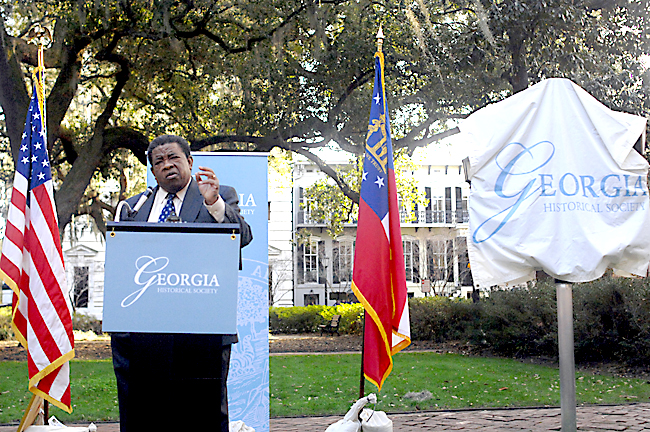 Charles Elmore talks about the history of "40-acres and a mule" during a dedication ceremony for "History of Emancipation: Special Field Orders No. 15," historical marker after it was unveiled Friday March 4, 2011, in Savannah, Ga. On the 150th anniversary of the start of the Civil War, a new historical marker in Savannah is calling attention to a milestone for black Americans that came at the war's end. (AP Photo/The Savannah Morning News, Richard Burkhart)
Charles Elmore talks about the history of "40-acres and a mule" during a dedication ceremony for "History of Emancipation: Special Field Orders No. 15," historical marker after it was unveiled Friday March 4, 2011, in Savannah, Ga. On the 150th anniversary of the start of the Civil War, a new historical marker in Savannah is calling attention to a milestone for black Americans that came at the war's end. (AP Photo/The Savannah Morning News, Richard Burkhart)SAVANNAH, Ga.-It was an attempt by the U.S. government to help former slaves on the road to freedom. Known by the phrase "40 acres and a mule," it came to symbolize America's broken promises during a century of struggles for black Americans following the Civil War.
The policy was hatched in Savannah by Gen. William T. Sherman in January 1865, a month after his Union troops captured the city. The idea: give thousands of freed slaves land seized from white planters on the Georgia coast, plus a mule to help farm it.
To coincide with the 150th anniversary of the first shots of the Civil War, the Georgia Historical Society unveiled a historical marker Friday summing up the history of "40 acres" outside the cotton merchant's mansion that served as Sherman's headquarters toward the end of the war. About 80 people gathered to watch in oak-shaded Madison Square.
"This was an event of national significance," said Todd Groce, the society's president. "You're at a point where African-Americans are beginning to make a transition out of generations of slavery. And we see just how long and painful a road that's going to be."
The "40 acres" policy actually came down as a military order, Special Field Orders 15, issued by Sherman after he met with Secretary of War Edwin Stanton and 20 black ministers.
The ministers were asked for advice on how to deal with thousands of freed slaves who had been following Sherman's army since its long march from Atlanta. The general didn't want them in tow, saying he couldn't feed or protect them.
Sherman's order granted the ex-slaves each 40 acres, to be located along the U.S. coast from Charleston, S.C., to the St. Johns River in Florida. The document didn't mention mules, but the Union troops had an excess and gave them away.
The promise of "40 acres" didn't last. A few months after Abraham Lincoln's assassination in April 1865, President Andrew Johnson ordered that lands seized from Southern whites be returned to them.
Many white planters allowed blacks to stay and keep farming their land, resulting in the sharecropper system that wasn't far removed from slavery.
While "40 acres" may have been about military expediency for Sherman, it held great hope for blacks yearning to profit from their own labor for the first time, said Hermina Glass-Avery, associate director of the Center for the Study of the Civil War Era at Kennesaw State University.
"Once a person owns property, they have a say in the government and a say in capitalism," Glass-Avery said. "That was the moment that could have made the difference between the levels of poverty, racism and discrimination that existed for at least another hundred years until the 1960s."
Georgia Historical Society: http://www.georgiahistory.com/